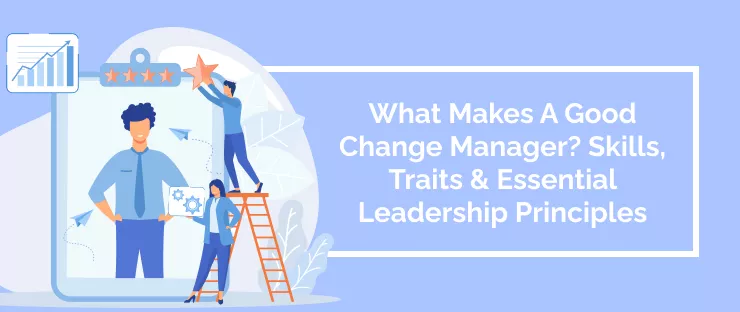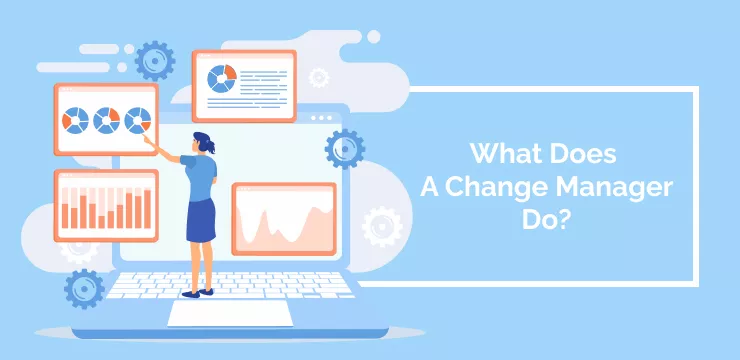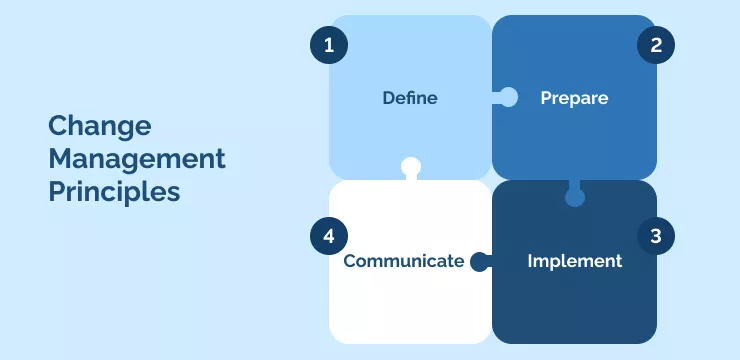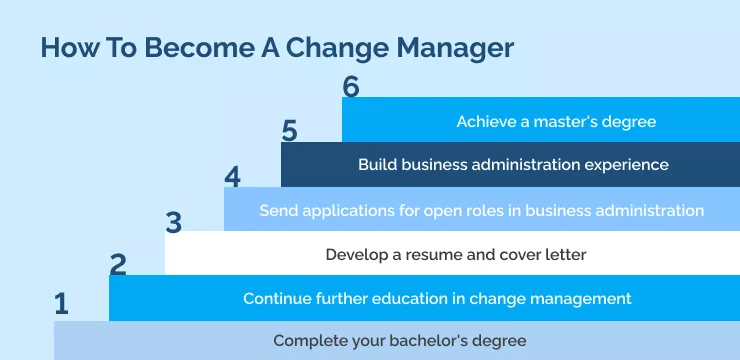
The change manager is one of the most critical roles in business today. Gartner reports that just 39% of employees feel able to respond to the changing needs of their business and the customers it serves. Disruption in the industry requires quick thinking, expertise, and excellent support skills to help team members successfully navigate change. Change managers become indispensable within this environment.
But what does a change manager do? What is change management? And what are the five leadership features of the change manager job role? These questions will be explored in detail, beginning with a definition of a change manager.
What Is A Change Manager?
A change manager is responsible for overseeing any changes in the workplace, and their primary goal is to make changes with as little disruption to company processes as possible. The concept of change management covers a broad range of structural, systemic, and strategic changes within a company that aims to optimize its current operations.
Change management is vital when discussing new or complex topics, such as political or technical challenges, if competitors are arising, or different market competition types. Change managers give guidance on how to handle questions and provide solutions on how to engage in organizational development (OD) strategies. Change managers can act solo, as part of a larger company, or internally.
Change managers are usually senior leaders and can be certified, although change management certification is less crucial than some employers may believe. Experience in change management practices is of higher value to companies.
What Is Change Management?
Change management provides executives with the tools to help employees transition successfully during large-scale changes. Doing so helps ensure that new behaviors become the norm, leading to improved business processes and results following the completion of the change management process.
Businesses need change management in various departments, such as intelligent regeneration, package versioning, state control, library control, configuration management, and turnover management.
Gartner shows that 48% of HR managers place organizational design and change management as their second highest priority. This statistic indicates that every organization requires change management strategies to embed a willingness to change in every business process across the entire workforce.
What Does A Change Manager Do?

The change manager plays a crucial role in change strategy success. This point occurs because change managers are responsible for initiating, documenting, and authorizing change processes. The change manager job description also includes designing organizational development strategies, justifying changes and restructuring, and estimating these changes’ costs, effects, advantages, and risks.
The change manager is responsible for developing a plan to mitigate risks and disruptions when implementing new processes. This plan is taken from situational and conflict analysis that all help to maximize employee adoption of change.
A change manager’s responsibilities typically include documenting, overseeing, and streamlining various processes. This role may involve holding individual or team meetings, handling internal corporate communication, and maintaining a balance of interests between different stakeholders. The change management job description divides into change management skills and traits.
Change Managers Vs. Project Managers
Many people question the role of a change manager when contrasted with a project manager. They appear to be two different roles; however, they can occasionally overlap in day-to-day work life during project management.
Generally, a project manager is responsible for completing tasks connected to finishing a project on time and within budget. Some of these tasks might necessitate changes to pre-existing processes and systems within project management. Often a project manager will oversee these changes, but usually, there is also a change manager who handles this process within the same stages of project management.
Change Manager Skills
Change managers are highly knowledgeable in risk mitigation tactics at the planning stage. Businesses also highly value time management skills capability for change managers as the success of change strategies depends on the completion of KPIs, requiring the ability to implement and measure success metrics. The change manager job description often includes a change management certification as proof of suitability for the role.
Excellent communication skills are needed to approach anticipated resistance in an even-handed, understanding, yet cost-effective manner. But equally significant is the ability to access change readiness scales as part of a change management strategy.
Change Manager Traits
One of the essential traits of a change manager is the ability to maintain strong relationships, which is key to managing anticipated resistance. Every change and organizational change manager must also hold experience with past change initiatives and the accompanying change management practices that lead to success.
An excellent change manager is passionate about understanding and implementing change management methodologies to increase employee adoption. Along with these efforts for employee adoption rates for change, change managers must solve organizational issues using intimate knowledge of the change process within previous change initiatives. And finally, every change manager must use their excellent communication and persuasion skills to support training efforts to implement and maintain change.
Five Leadership Features Of The Change Manager Job Role

Five change management levers or features exist that mark out the most successful change leadership. The first action begins with your values.
- Begin With Your Values
Gandhi’s most famous quote is, “Be the change you want to see.” The crucial point we can take from this is to understand the change. You must enact it yourself. Others will then follow.
To start the process, define your obstacles to success until you’re confident that you have improved yourself. The benefits are as follows:
- As a result of using this method, you will come across as more credible and authentic to those around you, in addition to fulfilling the role of a positive model.
- After employing this strategy, you will better understand your employees’ responses to change and know how to react supportively.
- Gaining an admiration for change transformation is key to understanding the process to adequately and responsibly lead change.
- Before going company-wide with any processes or measures, ensure managers are on board with change and its potential benefits for progress.
- Inspire A Creatively-Driven Shared Vision
The success of any company depends on the senior management’s ability to communicate a vivid and inspiring vision to their employees. Some great leaders are born with this trait, while others have learned it through different methods like coaching sessions. If you want to be an effective change leader, here is what you need to do:
- Inspire your employees and infect them with excitement.
- Develop a clear vision that staff can easily understand and get behind.
- Help them identify with the company by communicating the goals consistently and continuously. This vision then unifies them under a common goal.
- Join Employees On Their Transformation Journey
A change leader represents many symbols within a workplace: an intelligent strategist, a steadfast leader, and a coach who is always aware of what’s happening. This job description might sound impossible, but if you keep the following points in mind, change managers can fulfill all these roles. They do this by joining employees on their journey of change:
- Always be present and available to your employees daily, not just during monthly progress meetings.
- An open-door policy is inexpensive and easy to maintain, so express interest in your team’s success and watch them flourish together.
- You can develop a trusting, open communication culture by setting an example and being proactive.
- Reach out to your employees and be clear about the company’s objectives during the change process so they know where you stand.
- Try to avoid failure but also be honest about any mistakes.
- Working alongside your employees in their day-to-day lives provides additional benefits: Always keep up-to-date and aware of changes in the atmosphere and culture. Additionally, you can experience and counter stagnation or unhelpful behavior patterns as they occur.
- Encourage Others To Embody Change
Influential change leaders focus on creating an embodiment of change instead of compulsory enthusiasm. This method is more efficient than false motivation. People who embody a philosophy at their core do not need constant encouragement, which is why termination or bonuses are less effective.
- It’s common to feel fearful and hesitant when change occurs. Give your employees some time to process the transition internally. Be available to answer questions they may have
- Encourage employees to take the initiative and be responsible for their own decisions. This action will help them feel confident in dealing with new challenges and committed to the company.
- Facilitate networking and interaction between employees so they can get to know each other better.
- Identify key stakeholders and address their needs to address difficulties early. In short, involve them in the decision-making process from the very beginning.
- Persist and Be Determined To Make Positive Change
Change managers must constantly move forward and never give up, as they are the driving force of a change project. As a change manager, it may feel like you are taking three steps back for every two steps forward, but it is crucial that you don’t get discouraged, as change is complex and takes time to achieve.
There are several points to consider to help you persist with change and inspire team members to remain determined to make positive change:
- Setbacks are inevitable when aiming for change. What counts is not giving up.
- Persist with your vision while simultaneously being open to changes to the initial plan. Change is a journey as well as a destination.
- Short-term successes, repeated over time, will lift everyone’s spirits and keep them going in the long term.
- Resist any temptation to declare victory too soon; ensure this change becomes part of your company culture before celebrating.
When you understand the five leadership qualities of a change manager, it is helpful to integrate the four Cs of a first-class change manager. Bearing these four Cs in mind during change manager practice can help remind you of what is essential for success.
The 4 C’s of A First Class Change Manager
Change managers can ensure they embody the four Cs of success to inspire their employees to an effective transformation strategy. The first of these Cs is commitment.
1. Commitment
A top-tier change manager is dedicated to the significance of their role in projects and change programs, always considering those whom the changes will impact. This commitment manifests through a willingness to continuously develop their skills and competencies, constantly learning and growing within their roles with no finish line for development.
A successful change manager shows commitment to those going through change by empathizing with how difficult it can be and ensuring they support staff throughout the process. This approach builds trust and creates a plan for each person to successfully transform their practice, achieving project goals while positively impacting the organization’s culture.
2. Connections
To operate at their full potential, a change manager must understand the relationship between people, projects, processes, and outcomes.
- People connections allow them to wield influence throughout an organization, from upper management to entry-level employees.
- Project connections encompass understanding how each project impacts the organization and multiple projects’ combined and overarching effects.
- Process connections help to improve both business processes and solution delivery. They do this by integrating process activities and change capabilities within the organization and their common objectives.
- Outcome connections ensure that results align with the organization’s vision, strategy, goals, and objectives in a measurable, sustainable way.
3. Communication
A world-class change manager communicates openly, honestly, and honestly. Change managers are skilled at understanding employees’ strengths and weaknesses and how to develop them using excellent communication. They know the importance of aligning communication messages with what people care about and the problems they are trying to solve. And they leverage these connections to create attainable change outcomes, communicating lessons learned and celebrating successes.
4. Creativity
The best change managers in the business world utilize their creativity to formulate innovative, original ideas. These ideas make complex concepts more understandable and break large projects into smaller, more achievable goals. A skilled change manager isn’t confined to thinking inside the box and is always willing to try new things.
Change Management Principles

To fulfill their role, change managers must be aware of the four change management principles. The first of these principles involves defining the changes needed by the company.
1. Define
Asking questions gives change managers essential data to figure out how to work together more efficiently with teams and groups. And only after that should they proceed to the next step.
Answering these questions forms the basis for the preparation stage in which you respond to these questions with solutions. The next step is to prepare for the change.
2. Prepare
Different companies achieve successful change in different ways, depending on the company’s size and the type of change. Some have very structured change methodologies, while others practice with greater freedom. Additionally, how change leaders manage change projects differs based on the company.
3. Implement
Kotter’s 8-Step Change Model is only one example of a method that explains how to add a sense of urgency into your actions, so you maintain progress and everyone supports your changes.
The Change Curve is a helpful reminder to respect people’s emotions as you carry out your plan. It explains the psychological stages we experience during organizational alteration – from disbelief and denial to eventual total emotional and intellectual investment in the new status quo.
4. Communication
Change management’s success or failure depends mainly on the change manager’s communication skills. The messaging needs to be understandable so the target audience grasps the changes and why the company is carrying them out. But it’s not just logical explanations that will achieve success; people need emotional motivators too.
To successfully execute your plans, incorporate them with your organization’s mission or vision statements. Doing so helps people understand how the changes benefit the company and give them an inspiring vision for the future. Stakeholder management is another significant factor; make sure everyone receives updates as necessary for your project to run smoothly.
After your company has started to plan and carries out the four fundamental principles of change, it needs to establish what a change manager is before beginning to plan a transformation strategy.
What Are The Top 10 Reasons To Hire A Change Management Professional?
Change management professionals are essential to today’s business environment. There are seven main reasons for this, beginning with the ability to optimize change success.
- Optimize change successes – Data and experience show that change management is essential for achieving results. Change management capabilities help ensure success on critical projects and initiatives.
- Effectively manage change – If you want to stay ahead of the competition, learning to change and adapt is now more critical than ever.
- Reduce waste caused by unsuccessful change – In the past, organizations have failed to deliver successful changes. This situation led to much stress and tension in these workplaces. However, successful change is more likely when change managers coordinate transformation strategies.
- Align organizational values with practice – If your organization prioritizes its people, this case will be incredibly impactful for you.
- Protect against future disruption – The near future holds many changes for companies that they need to make to stay afloat and thrive.
- Maintain an efficient, consistent change philosophy – A uniform change management system across an organization leads to success.
- Developing essential internal operations – Change management is an important skill for all employees to help businesses succeed.
- Reduce employee churn by supporting staff during change efforts – When the team is more secure and comfortable in their role, they are more likely to stay at their employer despite the widescale change. This way, change managers help reduce employee churn, improving the company’s bottom line.
- Continued training innovations – Change managers continuously research new training methods to support staff with constant changes. Hiring change management allows companies to utilize employee training methods, driving skills through innovation, and investment in staff.
- Embed adaptability into company culture – When a team can cope with constant change, they will approach the variables of digital adoption with agility and adaptability. A more agile and adaptable workforce is a more resilient organization.
How To Become A Change Manager

The change manager’s role is highly specialized and responsible. But it can be hugely rewarding to see your business grow due to carefully considered and innovative changes. There are structured steps to becoming a change manager. The first involves completing a bachelor’s degree in a subject that relates to change management.
Complete your bachelor’s degree
To be an excellent change manager, you must understand how businesses operate and which processes cause positive or negative impacts on a company’s structure. A Bachelor’s degree in business administration, human resources, or economics will give you the tools you need to succeed.
Business degrees give students an understanding of how a company works, which students can achieve by completing other marketing and logistics degrees. The objective is to identify areas within the company that needs improvement and, as a professional, what you can do about it using the tools available. Most Bachelor’s degree programs take three years to complete; however, two-year accelerated programs are also available.
Continue further education in change management
You can specialize in project management by obtaining a related degree or getting a change management certification. If you want to lead the adoption of new technologies and manage organizational change, look into taking a Change Management Practitioner course. You can even take some of these courses online so that they can fit in with an excellent work-life balance.
Develop a resume and cover letter
Your resume and cover letter are crucial to landing a job after graduation. Even if you don’t have relevant work experience, focus on the transferable skills you’ve acquired during your studies, like managing change in a business context.
Your cover letter should highlight why you would excel in the role and state your dedication to professional development within the company. If you and your potential employer have compatible long-term goals, expressing interest in a change management position may result in being offered that role.
Send applications for open roles in business administration
Obtain the business administration skills you need by applying to open positions that will help you develop. By doing this, not only will your resume continuously be optimized, but it will also be easier to send it to HR. However, update your resume each time you apply to tailor it to the critical competencies required for each position.
Build business administration experience
Before changing a company’s operations, you must understand how they work. Talk to employees in different departments and learn about their roles and responsibilities. Once you know the current state of affairs, start thinking about ways to modernize and streamline tasks to make them more efficient.
Ideally, a change manager should have previous experience in operations management; some universities might even require it for admission into specific degree programs—for example, a Master’s degree in Project Management.
Achieve a master’s degree
Mastering project management can help you change a company’s operations. The program teaches students how to successfully begin and end projects while developing crucial skills such as time management, communication, and budgeting. If you want to think about another graduate route, consider getting your Master of Business Administration, which will give you the ability to become a business leader.
But qualifications and experience must make change managers reflect on what is the central force behind effectively driving change. They must constantly ask themselves if they focus on the exemplary aspects of change management. So, what goes the best change managers? Communication.
Communicate Meaningful Change
The change management job description includes many skills. Critical thinking, a solid understanding of verbal communication skills, and organizational development to boost employee adoption are essential.
But what uses are skills for project management and the skills to complete change management assessments without strong relationship ability? Change managers require outstanding communication skills to positively impact employees’ perception of change to achieve program objectives as they communicate the need for change in the most meaningful way.
Entire organization structures live and breathe change. This reason shows that it is vital to hire a change manager today to optimize business growth and become resilient for the future. Change becomes meaningful when change managers focus on building exceptional communication skills to unlock strong relationships with their staff.
Tristan Ovington
Tristan Ovington is a professional senior writer and journalist, specializing in providing expert insights on various topics such as digital adoption, digital transformation, change management, and Cloud apps. He delivers his knowledge through accessible online content that is data-driven and presented in a friendly tone, making it easy for readers to understand and implement.



